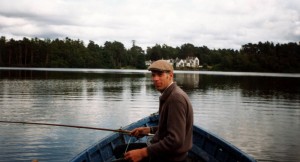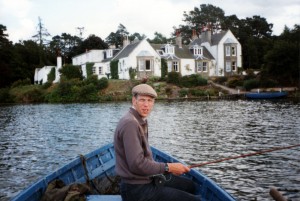
loch no bo with the estate house in the background
Loch na Bo is a picturesque but little known man made loch to the south of Lhanbryde. It is surrounded by woodland that was planted by the Earl of fife and is full of wildlife, including red squirrels, Daubenton (water) bats, and minks. The former tower house is the residence of the landowners with its manicured grounds and brings an undeniable air of distinction to the Moray loch, south east of Elgin. Loch na bo is a wild brown trout fishery and the last time the loch was stocked with fish was in 1960. There are two strains of naturally-spawned browns reside here the classic golden-bellied variety and the more silvery strain reminiscent of sea trout which are the descendants of Loch Leven trout introduced to the loch just after world war II.
My first visit to loch na bo was with my old fishing pal Jimmy he had fished here many times learning the craft as a young lad from his father as the seasons past into years Jimmy had learnt how best to fish loch no bo the best places that the trout could be found and the all important what fly to be using and when to be honest Jimmy made the best gillie any one could wish to meet. As we walked down to the jetty moored up are a couple of large wooden salmon fisher style boats these boats are heavy but very stable and their size make them idea for two anglers.
Depending on how you view the story a few years ago two local anglers claimed to have seen a monster trout. The Northern Scot ran the headline story “The loch no bo Monster” personally I feel that this type of fishing story in the long term is bad news for any wild trout fishery I guess it’s fair game if you’re talking about a put and take trout fishery where the owner puts in a few large rainbow trout once this fish has been seen the story spreads like wild fire among the angling community with the desired result of an increase in anglers hoping to be the lucky one to catch the monster. As Loch no bo is a wild trout fishery and has not been stocked for over fifty years this fish would be a trophy fish a once in a life time fish and I would sure keep it quite so as to increase my chances of catching it instead of increasing the pockets of the fishery owner.
“Near the boat jetty the famous story of the loch no bo monster was born”
Loch no bo is a cyclical water that might only peak in fish size every six or seven years in 2010 a lot of fish in the one and half to two pounds region have been caught if this continues then perhaps a peak will be soon reached and smaller fish will once again been the main stay of any fishing trip. The original loch was manmade and was deepened at the end of the 19th century to serve as a reservoir. Fed both by a spring and a burn inlet at its southern end the water drops from a depth of five foot to 21 feet in the hollow at the heart of the loch’s main bay adjacent to Loch Na Bo House. The southern end can be weedy as can the fringes generally in high summer although there is still plenty of fishable water. Take care if you decide to drift down the centre of the loch half way down is a sunken stone island. Both bays are worth exploring one at the western bank and the other bay at the north-east keep a look out for the rhododendrons overhanging the water the insect life falling from the vegetation can make fishing the margins particularly profitable.
I have Jimmy to thank for teaching me how to fish loch no bo – over the coming fishing seasons we have honed our fly fishing skills moving on from buying our flies from the local tackle shop to becoming accomplished fly tiers in our own right this adds a greater depth to our interest in fly fishing if you dress the fly yourself you can be sure that you have made it to the original pattern unlike the shop brought one which might be tied to the original pattern or on closer inspection is dressed using cheaper materials and is only a poor relative of the original and just leaves you feeling cold and cheated.
The natural step from trying your own flies is the fact the you become more interested in matching your flies to the hatch in order to be able to do this you will need to acquire some trout fly recognition skills there are some excellent books that you can buy from a first rate tackle shop and I have found the following two books to be most help full John Goddard’s Water side Guide The Angler’s pocket reference to the insects of rivers and lakes – how to identify and choose the matching artificial my copy was printed in 1988 I paid £7.95. I have also found “Trout fly Recognition” by John Goddard very helpful the book was first published in 1966 and my copy was published in hardback in 1983 when I paid £9.99 both these books together cost more than a year’s fishing on my local river when in 1989 a season was costing £12 for an adult to fish for Salmon, sea trout and brown trout.
Taking time to learn a little about matching the artificial to the hatch can pay dividends as it can be the difference between a blank and a brace of wild brown trout in the creel for supper any one can turn up at the trout fishery and inquire from the game keeper the names of the killing pattern flies and he will have a small armoury of names of patterns that have caught fish he might even point out the hot spots that anglers having being fishing in but from my personal experience I have learnt that the fishing hot spots are always close to the car park if its bank fishing and near to the fishing jetty if its boat fishing. Should the game keeper on the other hand not name any flies by the anglers fly patterns and he inform you that “Chironomids” are a good family of flies to start with you will be able to hold your head up if you have learnt the art of trout fly recognition and this will mark you out from the lure fisherman Chironomids are of course midges and is better known to the angler as buzzers these small to medium-size insects have a large cylindrically-shaped bodies with two transparent wings lying flat on top this is a relatively large family with over 380 British species.
When appropriate various fly fishing styles and techniques can be tried the choice of fly will depend upon matching the fly hatch at the time of your visit a wet fly option might be black Pennell, bibo, and a small black spider or The Greenwell glory or a pheasant tail nymph. The Loch is boat fishing only with just three boats it is essential that should you want to fish Loch no bo you will need to book in advance.

